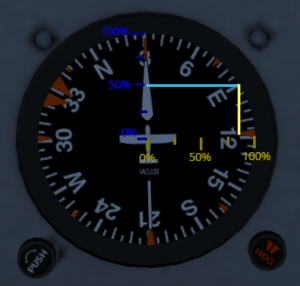Crossswind
Whenever there is wind, it will affect your flight.
You can decompose the wind vector into a crosswind and a headwind (or tailwind) component. Crosswind is the wind affecting you from the side, headwind affects you from the front (it will raise performance) and tailwind from behind (which lowers performance).
The crosswind will blow you off your desired ground track if you do not counter. This can lead to missing the runway or getting of-course.
Trick[1] to quickly estimate the crosswind using the HI/DG
You can quickly and easily estimate the headwind and crosswind components by using the markings on your Directional Gyro. For this you will treat the line from the center of the instrument (where the plane is depicted) as 0% mark, and the edge where the numbers are as 100%.
Look at the picture right:
You are flying a Heading of 030. Assume wind (09012KT) is coming from 090 and blows with 12 knots.
- Headwind (blue line / vertical axis):
- You draw a horizontal line (blue) from the wind position to an imaginery vertical line in the center. Where the line hits the centerline will give you the "mark" for the headwind component in percent.
- In this case, the line starts at the 090 edge and extends to the left. At the vertical centerline it hits an estimated position of 50%.
- 50% * 12Kt = 6KT headwind.
- Crosswind (yellow line / horizontal axis):
- You draw a vertical line from the wind position to an imaginery horizontal line in the center. Again, where the yellow line crosses that centerline is your "mark" in percent.
- In this case, again we start at the 090 edge position and extend downwards, where it roughly marks about 80%.
- 80% * 12Kt = 9,6Kt crosswind from the right.
Final estimation: we face a rounded 10Kt crosswind from the right.
